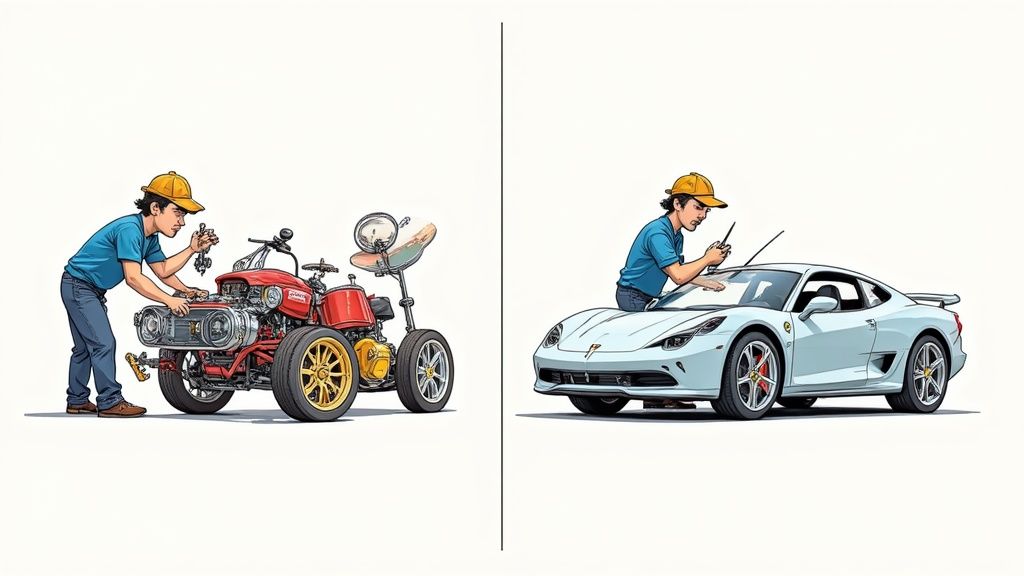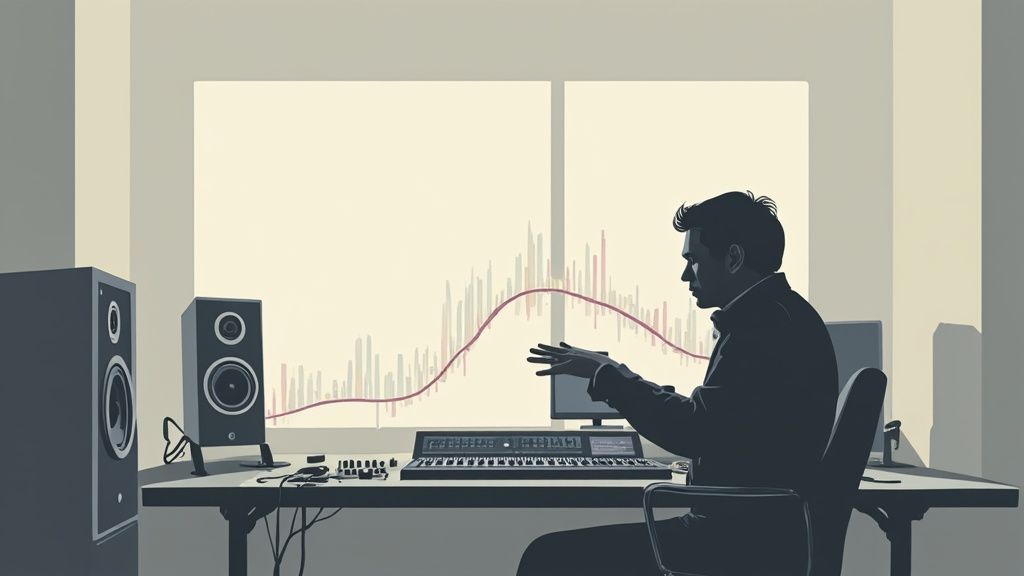Let's get one thing straight right away: mixing is about building the song, while mastering is about getting it ready for the world. It’s the difference between a chef carefully combining every ingredient to create the perfect dish, and the person who then plates that dish beautifully for the restaurant.
Both are critical, but they operate on totally different levels.

Even though people often lump them together, mixing and mastering are two completely separate stages of making a record. Each requires a unique mindset and has its own set of goals.
Mixing is where the creative magic really happens. You’re deep in the trenches with dozens of individual tracks—vocals, drums, synths, guitars—and your job is to make them all sit together perfectly. It’s an intricate, artistic process of balancing, shaping, and enhancing every sound to create a cohesive whole.
Mastering, on the other hand, is the final quality check. You’re no longer working with individual tracks; you’re treating the entire finished mix as one single audio file. This is where you make broad-stroke adjustments to get the song ready for Spotify, Apple Music, and everywhere else. You’re focused on competitive loudness, consistent tone, and making sure it sounds great on everything from a car stereo to a pair of earbuds.
Sure, you might use similar tools in both stages. For instance, knowing what does compression do in music is essential for both, but how you apply it is night and day. In mixing, it's surgical. In mastering, it’s all about subtle, transparent glue.
To really hammer home the difference, let’s break it down side-by-side. This table gives you a clear snapshot of how these two processes differ in their goals, focus, and scope.
At the end of the day, mixing creates the song, and mastering prepares it for public consumption. One can't exist without the other, and respecting each stage is the key to a professional-sounding record.

This is where the magic really starts. Mixing takes all those raw, individual recordings and turns them into a single, cohesive track that actually feels like a song. Think of it like cooking a complex dish. You have all these separate ingredients—drums, bass, vocals, synths—and the mix is where you balance the flavors so nothing is overpowering and everything works together.
The person behind the console, the mix engineer, is part artist, part scientist. Their job is to make a thousand tiny decisions at the track level, all in service of bringing the artist’s vision to life before it gets that final coat of polish.
A mix engineer is obsessed with the internal relationships within a song. It's all about how each instrument and vocal sits next to the others. Every move is a surgical one, designed to carve out the perfect sonic space for each element.
Here's what that looks like in practice:
The real difference between mixing and mastering comes down to focus. Mixing is all about the relationships between the tracks inside a song. Mastering is about the relationship between that finished song and the outside world.
Ultimately, mixing is about building the sonic world your song will inhabit. It’s a foundational, detail-oriented process that combines countless edits and creative choices. And it’s so critical that the market for mixing consoles is projected to more than double by 2035, jumping from $780.3 million to $1.89 billion. You can discover more insights on Future Market Insights about this trend.
Once the creative flurry of mixing is over, mastering steps in with a calm, analytical approach. This is the very last stage before your song goes out into the world, and it has a completely different job. The mastering engineer is essentially the quality control expert, giving the final sign-off that your track is ready for prime time.
They aren’t nudging individual faders for the kick or snare. Instead, they're working with the finished stereo file, making broad, subtle tweaks to the entire song. The whole point is to get it ready for distribution—making sure it sounds powerful, polished, and consistent no matter where someone is listening.
This last bit of audio magic is a huge deal and can make or break a song's commercial success. The industry knows it, too. The global market for audio editing and mastering systems was valued at USD 11.32 billion and is expected to jump to USD 29.43 billion by 2033. If you're curious, you can read more about the audio mastering market and see just how critical this step has become.
A huge part of a mastering engineer's job is to bring a fresh set of ears to the project. They’re listening on incredibly precise speakers in a room built for critical listening, so they can spot problems the mix engineer might have missed after hearing the track a few hundred times.
Their main goals are pretty straightforward:
The core difference between mix and master is perspective. Mixing is an internal process of building a song piece by piece. Mastering is an external process of preparing that finished song for every possible listener.
To pull this off, mastering engineers use a very specific toolkit of high-precision gear. They might use a multi-band compressor, for example, to get a handle on the dynamics in just one frequency area—like taming a boomy low end without messing with the shimmer of the cymbals. Every move is slight, transparent, and all about serving the final listening experience.
https://www.youtube.com/embed/Szv32PCJfs0
To really get the difference between mixing and mastering, you have to look past the plugins and techniques. It's really about the mindset. It’s the classic artist versus technician dilemma, with each role looking at the song from a completely different angle.
A mixing engineer is an artist working inside the painting. Their job is internal, creative, and obsessed with the details. They're building the song's emotional core, making thousands of tiny decisions like how the kick and bass need to sit together, or exactly where a vocal harmony should live in the stereo field. Every tool they grab is for sculpting and shaping individual sounds.
The mastering engineer? They're more like the gallery curator standing outside the finished painting. Their perspective is external, objective, and big-picture. They aren't worried about individual brushstrokes; they care about how the entire piece hangs on the wall, how it stacks up against other works in the room, and how it looks under different lights.
This is a great way to think about the three main goals of mastering: loudness, balance, and translation.

At the end of the day, these objectives just make sure the song is ready for the world, sounding professional and consistent no matter where it's played.
The gear and software used in each stage reflect this core difference in approach. A mixer's toolkit is full of surgical instruments. A mastering engineer's setup is built for broad, transparent adjustments.
Mixing is the act of creation, focused on building a song from its individual parts. Mastering is the act of translation, focused on preparing that song for the outside world.
To make this distinction dead simple, let's break down how their focus and tools differ in a side-by-side comparison. This table lays out the core differences you need to know.
As you can see, it's not just a different set of steps; it’s a fundamentally different job with a different end goal. The mixer builds the car, and the mastering engineer details it for the showroom floor.

Let's be real—technology is completely changing how we make music, and AI is right at the center of it all. We're seeing new AI-powered tools pop up for both mixing and mastering, all designed to speed things up and put a professional sound within reach for everyone.
During the mix, AI plugins are like having a junior engineer on hand. They can listen to your tracks and suggest EQ tweaks to stop a kick drum and bass from fighting, or carve out just the right amount of space for a vocal to sit perfectly in a busy track. It’s a huge time-saver on the more tedious, technical stuff.
But where AI is really making waves is in mastering. The boom in automated online services has handed independent artists a solid alternative to booking expensive studio time. A recent survey found that over 40% of independent artists have either used or thought about using AI mastering. That’s a huge shift in how music gets finished.
These platforms can take a final mix and process it in just a few minutes, something that used to take days of back-and-forth with an engineer.
While AI brings incredible speed and affordability, the core difference between mixing and mastering still stands. AI in mixing is about assisting creative decisions, while AI in mastering is focused on automating that final technical polish.
Of course, this automation has its pros and cons. The accessibility is a massive win for artists on a budget, but you can sometimes lose the nuanced, gut-feeling touch of an experienced human engineer. Still, services like our own CarMaster AI mastering are designed to close that gap by offering specialized processing that gets your music ready for specific listening environments, like the car. If you want to dig deeper into these shifts, this piece on AI integration in post-production shows just how much the entire industry is being affected.
Even when you think you’ve got it all figured out, the real world throws curveballs that blur the lines between mixing and mastering. Getting straight answers is the only way to make smart calls in the studio and dodge those rookie mistakes.
Let's clear up a few of the big ones.
Technically, you can, but I wouldn't. It's a classic case of not being able to see the forest for the trees. Mixing is all about getting lost in the details—the individual tracks, the creative effects. You're deep in it.
Mastering, on the other hand, demands a fresh, objective ear. You need to pull back and hear the song as a complete piece. The best way to do that? Finish your mix, walk away for at least a day, and then come back for mastering. That separation is crucial for getting the perspective you need for those big, final adjustments.
Think of stem mastering as a middle ground between a full-blown mix and a standard master. Instead of giving the engineer a single stereo file, you bounce out a few grouped tracks, or "stems"—maybe one for drums, one for bass, one for all the vocals, and another for the instruments.
This gives the mastering engineer way more control. If the drums are a little too loud or the vocals need to pop just a bit more, they can tweak just that stem without messing up the whole balance. It’s more precise than stereo mastering but much faster and cheaper than sending the track back for a complete mix revision.
Stem mastering is the "best of both worlds." It gives you more flexibility and surgical control than traditional mastering without the time and cost of a full mix-down.
This is non-negotiable. If you want a killer master, you have to give your engineer (or an AI service) a solid foundation to work with.
First, export your final mix as a high-resolution audio file. A 24-bit WAV file is the industry standard for a reason.
More importantly, you absolutely have to leave headroom. Make sure the loudest parts of your track peak somewhere between -6dBFS and -3dBFS. And whatever you do, do not put a limiter or maximizer on your main output. That’s the mastering engineer's job. Leaving them that dynamic space to work with is the single most important thing you can do to ensure a great-sounding final master.
Ready to get your music sounding incredible in the car? CarMaster uses purpose-built AI to deliver professional, car-ready masters in minutes. Protect your songs from playback issues and get the clean, impactful sound they deserve. Try it free today at https://www.carmaster.io.